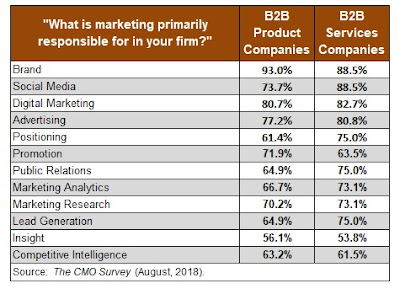Earlier this month, the Content Marketing Institute and MarketingProfs published the findings of their latest B2B content marketing survey. The B2B Content Marketing 2019: Benchmarks, Budgets, and Trends-North America report presents findings from 771 North American respondents who indicated their company primarily sells to other businesses.
CMI and MarketingProfs made a fairly significant change to their methodology for this survey. This year, they qualified respondents based on whether their company has been using content marketing for at least one year, and whether they are (a) a content marketer, (b) someone who is involved with the content marketing function, and/or (c) someone to whom the content marketing function reports. The qualified respondents represented a wide range of industries and company sizes.
For the past several years, the CMI/MarketingProfs survey report has highlighted important differences between "most successful" and "least successful" content marketers. In the latest survey, the "most successful" marketers include respondents who characterized their company's overall content marketing approach as extremely or very successful, while the "least successful" marketers are those who rated their company's content marketing effort as minimally or not at all successful.
The following table shows some of the important differences between the most successful and least successful content marketers identified in the new survey:
Most of the differences shown in this table have also been seen in earlier versions of the survey. For example, the importance of having a documented content strategy was first identified in the 2014 edition of the survey. So, most of these findings are not particularly surprising.
One of the more interesting findings in the latest survey deals with buyer trust. Ninety-six percent of the most successful marketers agreed that their customers and prospects view their organization as "a credible and trusted resource." Even more surprising, about three out of four (74%) of the least successful marketers also agreed with that statement.
Other recent research has painted a different picture regarding buyer trust. For example, the 2018 B2B Buying Disconnect study by TrustRadius was a survey of 488 individuals who had played a significant role in a business technology purchase within the preceding year. In this research, survey participants were asked to select which sources of information they use during their purchasing process from a list of 15 options.
TrustRadius also asked survey participants to rate the trustworthiness of each information source, and the five least trustworthy sources identified by respondents were:
- Vendor marketing collateral
- Vendor blog
- Vendor-produced case studies
- Vendor/product website
- Vendor representative
It's difficult to reconcile these findings with those in the CMI/MarketingProfs survey. It's possible, of course, that the business technology buyers surveyed by TrustRadius are simply more skeptical about vendor information than other B2B buyers.
It seems more likely, however, that the marketers responding to the CMI/MarketingProfs survey have an overly optimistic opinion about the level of trust they've earned from prospects and customers. Several other recent studies have shown that business buyers tend to view vendor-provided content with a considerable amount of skepticism.
One possible explanation for this apparent disconnect between content marketers and business buyers may relate to how marketers learn about the needs and perceptions of their prospects and customers. When the marketers surveyed by CMI and MarketingProfs were asked what techniques they use to research their audience, the top three methods identified were:
- Sales team feedback (74% of respondents)
- Website analytics (73%)
- Keyword research (65%)
Only half of the respondents said they use primary research to learn about their target audience, and even fewer (42%) reported using customer conversations or panels. While sales team feedback, website analytics, and keyword research can all produce valuable data for marketers, those techniques won't consistently provide reliable insights about buyer trust.
Trustworthy and credible content is now essential for marketing success. Therefore, it's imperative for marketers to get a regular, objective assessment of the level of trust their content is earning from prospects and customers.
Top image source: Content Marketing Institute and MarketingProfs













